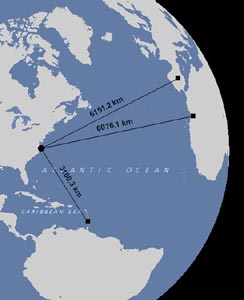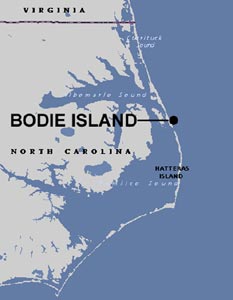|
DXpedition to The Outer
Banks of North Carolina
March 5-7, 2004
by John H. Bryant
and Harold N. Cones
Harold
Cones lives in Newport News, Virginia and vacations
regularly on the Outer Banks of North Carolina,
which lay about 2 hours to his south. Given the
success of other coastal sites for long distance
reception on medium and shortwave (Nova Scotia,
Maine and Mass. on the East Coast and Vancouver
Island and Washington State in the west) in the
past decade, Harold decided to use the occasion
of John Bryant's visit to Virginia to test the suitability
of the Outer Banks for similar activities.
A preliminary visit by Harold indicated few if any
motels or rental properties where 500 to 2000 foot
longwire antennas might be stretched between the
structure and the Atlantic shoreline. Thus, we opted
to concentrate on "12 volt DXing" from
vehicles. Harold was able to identify several areas
where a 500 to 1000 foot single Beverage antenna
might be stretched for a single evening of DXing.
He eventually located a site which would accommodate
a fan of three antennas: 1000 feet Northeast to
Europe, 500 feet East to the Mediterranean and 1000
feet SE to the Caribbean and South America from
the eastern shore of Bodie Island, one of the northerly
Outer Banks barrier islands.
  |
Unfortunately, none
of the locations that we identified are really useable
during the rather lengthy tourist seasons on the
Outer Banks. The population density of both year-round
residents and “shoulder season” visitors
was rather amazing to John Bryant, being used to
the relatively unpopulated wilds of the Northwest
Coast. Even in the early spring, visitors to the
beaches were numerous enough to delay antenna installation
until the last vestiges of daylight and to force
the removal of all antennas at or soon after dawn,
each day.
Daily
Notes: Evening of Mar 4/5
Set up at the site
for first time. 1000 feet NE (Europe), 500 feet
E (Med. and Africa), 1000 feet SE (Carib. and SAm.)
Harold Cones was using a NRD-525 receiver, operating
on 12 vDC. John Bryant was using both a NRD-535
and a Ten Tec 320 computer-controlled receiver.
 Due
to the unfamiliar new set-up and late arrival at
the site, we missed the hour of pre-sunset DX. First
tuned medium waves at about 2330, almost an hour...
Some European signals were present, primarily on
the mid and lower segments of the band. Higher frequency
MW Trans-Atlantic signals were absent. Monitored
MW and LW until about 0600 UTC. Long wave signal
levels seemed quite good, though they, too, seemed
to favor the Mediterranean area rather than more
northerly transmitter sites. Due
to the unfamiliar new set-up and late arrival at
the site, we missed the hour of pre-sunset DX. First
tuned medium waves at about 2330, almost an hour...
Some European signals were present, primarily on
the mid and lower segments of the band. Higher frequency
MW Trans-Atlantic signals were absent. Monitored
MW and LW until about 0600 UTC. Long wave signal
levels seemed quite good, though they, too, seemed
to favor the Mediterranean area rather than more
northerly transmitter sites.
The fair to good medium wave
Trans-Atlantic signals were, with very few exceptions
restricted to those from transmitter sites along
the shores of the Mediterranean. France Inter Network,
Toulouse, 945 kHz. was excellent, while the French
stations on 1206 kHz. (F. Inter, Bordeaux) and 1377
(F. Inter, Lille) were poor to absent. Even the
Spanish stations, prevalent at other East Coast
locations were largely absent or in only as hets/threshold
audio. A number of the Caribbean MW signals were
at excellent levels on the SE wire. No real effort
was made toward monitoring signals from South America.
Reception of the morning sign-ons of a number of
“nearby” West African MW stations was
expected; careful monitoring was not rewarded as
no signals were heard, even at sub-threshold levels.
Long wave was certainly more
rewarding than medium wave.
Daily Notes: Evening
of Mar 5/6
Arrived at the site earlier and
accomplished the set-up much more efficiently. We
were tuning the bands by 2239 UTC. Noted a sub-audible
signal on 1521 for about 15 minutes; this was almost
certainly the large transmitter in Saudi Arabia.
Throughout the evening, other Trans-Atlantic MW
signals were noted, but with the exception France
Inter Bordeaux on 1206 even the audible signals
were at threshold levels. Long wave and Caribbean
signals continued to be good to excellent.
Daily Notes: Evening
of Mar 6/7
 Signals
on the northerly routes to Europe had been absent
both of the previous evenings, so we opted not to
erect the NE Beverage. It had been a useless antenna
for both of the previous sessions. Signals
on the northerly routes to Europe had been absent
both of the previous evenings, so we opted not to
erect the NE Beverage. It had been a useless antenna
for both of the previous sessions.
Again, we were able to begin listening soon after
2230, about 45 minutes before local sunset. Trans-Atlantic
MW signals were even poorer than on the previous
night. During the first three hours of the evening,
no Trans-Atlantic MW signals were heard above threshold
levels. Long wave continued to be full of signals.
Those LW stations and the MW stations in the Caribbean
were the only easily available targets. Bryant gave
up in disgust and was bedded down in the back of
his Toyota Matrix by 9PM. Harold Cones lasted about
2 hours longer, catching up on long wave and netting
TRT Turkey on 180 kHz. See a full list of mediumwave
and longwave stations in the DXpedition
log.
Propagation
The propagation conditions encountered
on our three day DXpedition seemed quite poor to
us, at the time on medium wave, only moderately
good on the shortwave bands. Thankfully, the reception
conditions on long wave appeared to be excellent,
with fairly predictable reception of most, if not
all LW broadcast outlets from northern Africa, southern
and central Europe.
Since we have returned, we’ve
found several other sources of propagation data
to illuminate what we experienced, at least a bit.
First, Nick Hall-Patch has been running a continuous
propagation monitoring project for several years
now, automatically noting the strengths of Trans-Pacific
medium wave signals very accurately each morning.
He was kind enough to share the results of his monitoring
for the relevant three mornings. His results for
our first two nights indicate only fair strength
on TP signals, but at least some presence of both
high and low latitude paths (from his QTH of Victoria,
BC to Japan/Korea and Down Under, respectively.)
His results for Sunday AM, about 10 hours after
our third evening DX session ended, indicated a
significant opening in the higher MW frequencies
on high latitude paths (as shown by 1566-Korea.)
It is interesting to note that our only even partial
reception of 1314-Norway was at the previous sunset.
We may have noted the beginning of a high latitude
opening.

Two sets of loggings have been published on-line
that also bear on our experience. Martin Hall from
Clashmore, Scotland reported that, between 0645
and 0900 on March 4, conditions were “not as
good as yesterday – quite a lot of LA stations
about, dominating, plus some Canadian Maritimes
and the usual X-banders, but not a lot of note.
Fairly unstable with signals up and down in strength.”
He went on to log a number of Columbians, a Venezuelan,
a Cuban and a Mexican station. His session ended
about 14 hours before our first one started. It
might be significant that Martin noted declining
conditions and a southerly, low-latitude path, just
as we did. (Our conditions on MW were southerly
and went from bad to worst, literally.) Patrick
Martin of Seaside, OR reported on his DX between
1400 and 1500 UTC, also on March 4, about 9 hours
before we began. He found “A fair DU morning,
but with a “twist,” a new one, 8RN-639-Katherine,
NT popped in briefly at 1430 with an ID!… Nabbing
my second NT catch was a thrill!” His six loggings
in that hour were mostly DU “regulars,”
with the addition of a possible 6WA-Wagin on 558.
While we are deeply jealous of 8RN, otherwise, it
was as Patrick stated, only a “fair” DU
morning… again, a southerly, low-latitude route.
Unanswered Questions
 It
is not really possible to assess the quality of
MW propagation on the Outer Banks on the strength
of one single testing session. Several other aspects
of an overall assessment as a listening site are
clear, however. Thanks to population pressures and
quite narrow beaches, good listening sites on the
northern half of the Banks are few and far between.
It appears highly unlikely that a good site for
the more relaxed “120 volt” style of DXing
listening can be found at all. It
is not really possible to assess the quality of
MW propagation on the Outer Banks on the strength
of one single testing session. Several other aspects
of an overall assessment as a listening site are
clear, however. Thanks to population pressures and
quite narrow beaches, good listening sites on the
northern half of the Banks are few and far between.
It appears highly unlikely that a good site for
the more relaxed “120 volt” style of DXing
listening can be found at all.
From a propagational point of
view, the first question has to be “Where were
the Spanish stations?” The Great Circle route
to Spain from the Cape Hatteras area essentially
parallels our East Coast on a ENE path. Thus, the
distance to Spain is considerably farther than it
is from either Maine/Mass. or Nova Scotia. However,
the signals seemed, intuitively, to be poorer than
could be accounted for by the increased distance,
especially when the French stations seemed more
prominent than expected. Could it be that the Outer
Banks are in the first or second “skip zone”
of most of Spain, with signals skipping over and
largely missing the area?
Obviously, if we are to really
access the Outer Banks, such a unique geographic
feature, as a radio monitoring site, we will have
to make several more visits. It’s a nasty job,
but someone really needs to do it.
  
|